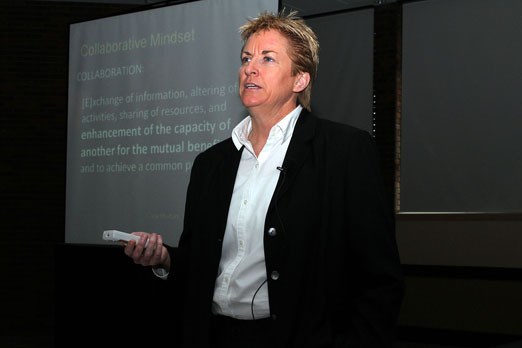Lori Moriarity recalls being a cop and visiting the same meth-lab compound five times on five different busts.
But with guns drawn and congratulatory high-fives all around for a job well done, four times the officers making the bust failed to see the entire picture.
Amidst the filth and dangerous chemicals, were children’s toys, strewn about the living room. Near the front door, a tiny pair of shoes was found, and outside, leaning against the front porch, a child’s bike rested, awaiting its next adventure.
Four times officers ignored the fact a child was living in danger, surrounded by a drug-filled, criminal lifestyle that all but guaranteed the youngster would follows suit.
On the fifth visit, reality set in and the child was taken out of the illicit environment and started down the path to normalcy.
Moriarity is the vice-president for the American-based National Alliance for Drug Endangered Children and a former police officer.
The little boy she spoke of is one of thousands living in similar situations throughout North America, but it’s only recently concerted efforts have been made to rectify the problem and break the cycle the inevitably leads to drug abuse and criminal activity.
“I think all of us have missed children growing up in substance-abuse homes and missed opportunities to intervene in the lives of a child and help break the cycle of abuse and neglect and change the trajectory,” Moriarity said, speaking to social workers and law enforcement agencies on the second day of a drug endangered children’s workshop, which wrapped up Wednesday in Thunder Bay.
“I think sometimes we all want to stand back. We don’t want to interfere in someone’s lives when tragic events are happening. We hope someone else is taking care of it, or we hope someone else is intervening, when in reality, especially with substance abuse issues, it’s going to take all of us.”
Sgt. Greg Stein is a training officer with Thunder Bay Police Services. Faced with a growing drug problem, particularly prescription drugs, he said local police, in the city and in the region, are starting to face more and more situations where children are forced to live with drugs in the home.
Ensuring the mechanisms are there to deal with the problem is one of the main reasons behind the conference, he said.
“The idea is to gather all the partners, social services, health care, education and law enforcement, to get them together and exchange ideas and learn strategies and better prepare themselves for what we have to deal with in the future,” Stein said.
“Children are the future of our society, so we need to do all we can to protect them and make things better for the community.”
According to the Toronto Star, about five per cent of Ontarians are addicted to or use painkillers illegally.
Kiti Freier-Randall, a pediatric neuro-developmental psychologist based in California has worked with children for 23 years, said the effects on children are grave growing up in homes where substances are used.
Parents who use drugs often say their children aren’t affected by it, but they’re dead wrong, Freier-Randall said.
“One thing we do know is the cycle of abuse, for them becoming substance users or perpetuating situations of danger in their community or in their homes is something they’re at very high risk for,” she said.
“The danger is of course that then these young people, our children, will be the next future generation of substance abusers, people who will have mental health issues, who will have difficulty contributing positively in our environment and will perpetuate potential violence in our community.”
Moriarity said by just focusing on the person with substance abuse, the problem of endangered children won’t go away.
Thinking of the next generation and working together with other agencies is the key to success. It’s something that will take time to co-ordinate, but it has to start somewhere, she said.
“There’s no child we want to say, ‘We don’t want to provide service to you,” Moriarty said, her law enforcement background showing through. “If our ultimate goal in our community is to see that all of our children are growing up happy, healthy and safe, it means we have a responsibility to do our job better, thinking of it more outside the scope of law enforcement.
“What is my response to this scene look like from child welfare, what does it look like for child treatment providers, what does it look like to the medical community? What is it that I can do today while I’m in this home that gives information to all of the systems to make better decisions for the child and his family.”
